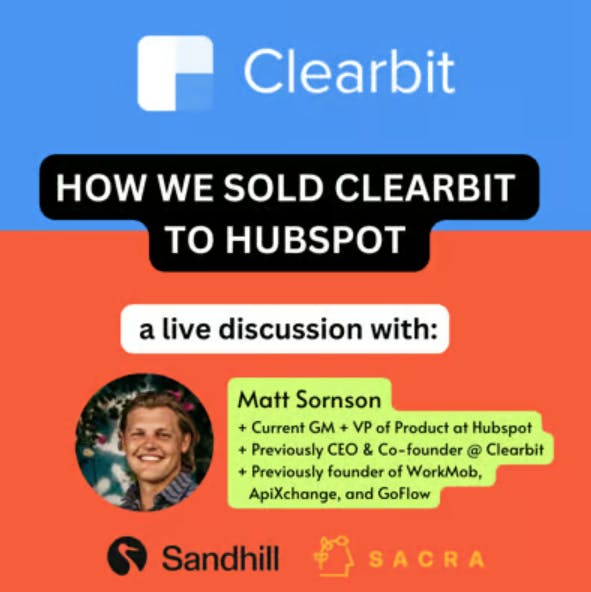Why HubSpot acquired Clearbit
 Jan-Erik Asplund
Jan-Erik Asplund
On Wednesday, HubSpot (NYSE: HUBS) announced that it was acquiring data enrichment platform Clearbit and its data on 20 million companies and 500 million people.
Back in March, we interviewed the co-founder and ex-CEO of Clearbit, Matt Sornson, about Clearbit’s competitive positioning vis-a-vis HubSpot and vertically integrated sales intelligence companies like Apollo (dataset).
Key points from our interview:
- Clearbit launched in 2014 as an API for business data and found product-market fit as a way for technical marketers to easily bring data into their sales & marketing automation tools to personalize their go-to-market campaigns. Prior to Clearbit, marketers bought CSVs from Zoominfo, Dun & Bradstreet or Jigsaw (acquired by Salesforce in 2010) and manually uploaded them to Salesforce—after, technical marketers used no-code and low-code tools like Zapier and Segment to pump that data into Salesforce programmatically. (link)
- Meanwhile, circa 2012, the rich, flexible user model of Salesforce began to move downmarket with HubSpot, Klaviyo ($580M in ARR), Intercom ($250M revenue in 2022), Customer.io ($50M ARR) and others all enabling sales & marketing teams to enrich customer data with custom user attributes. Clearbit became the data merchant for the rising growth marketing stack that included Clearbit for the data itself, Segment and Zapier to move that data between tools, and a HubSpot as the CRM to send and manage the go-to-market campaigns. (link)
- In 2015, incumbent data provider Zoominfo repositioned itself as a go-to-market platform that vertically integrated business data with CRM and sales & marketing automation, growing to $1.2B in revenue in 2023. Similarly, go-to-market upstart Apollo.io built sales engagement tools around their database of 265M contacts, growing 12x since 2020 from $8M ARR to $96M ARR. (link)
- Bundling is occurring across revenue operations (revops) tools, bringing tools like HubSpot (CRM), Zoominfo (go-to-market), 6sense (account-based marketing) and Gong (revenue intelligence) into fierce competition. The proliferation of SaaS tools for sales and marketing is now swinging back the other way as teams look to consolidate the different workflows and screens their SDRs and marketers need to touch. (link)
- LinkedIn’s sales suite, powered by their data on 950M+ members, has quietly grown to $1B+ in revenue—by acquiring Clearbit, HubSpot can natively integrate all of LinkedIn’s public data into its CRM for a "batteries included" user experience. Unlike with Salesforce’s acquisition of the now-shuttered Jigsaw in 2010, Clearbit’s downside risk is mitigated by its purely programmatic scraping of exclusively public data sources—the long-term upside lies in owning both data and the customer record to drive a step function increase in AI personalization in sales & marketing. (link)
For more, check out this research from our platform:
- Matt Sornson, co-founder & ex-CEO at Clearbit, on vertically integrated data and workflow tools in sales and marketing
- Colin Nederkoorn, founder & CEO at Customer.io, on the CDP layer in messaging
- Brian Whalley, Co-Founder of Wonderment, on Klaviyo's product-market fit
- Sean Lynch, co-founder of Census, on reverse ETL's role in the modern data stack
- Apollo (dataset)
- Customer.io (dataset)
- Intercom (dataset)
- Klaviyo (dataset)








